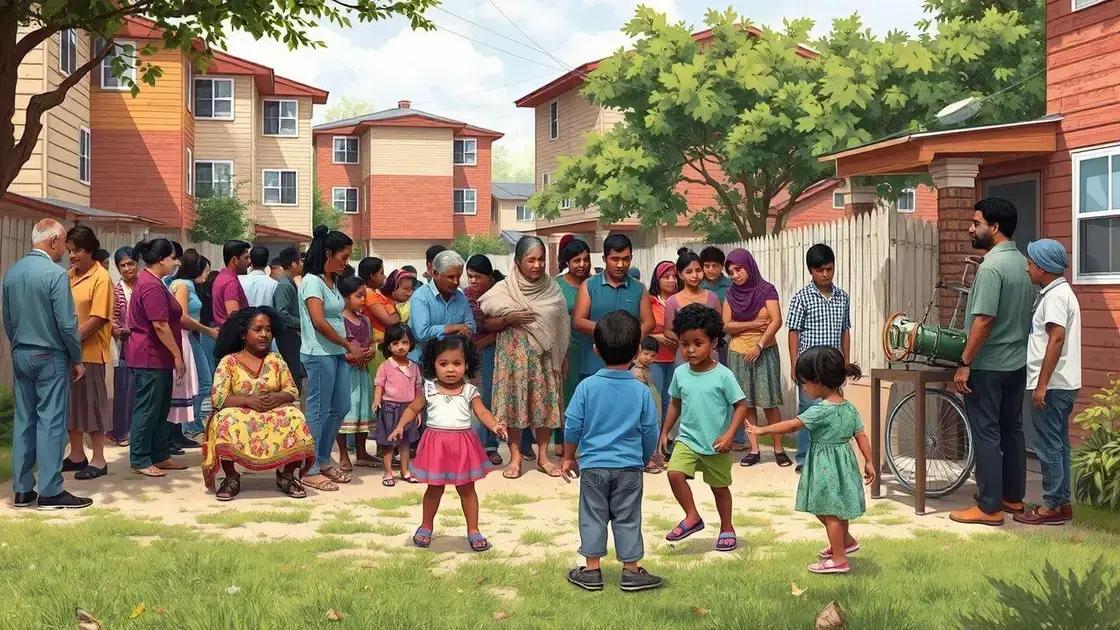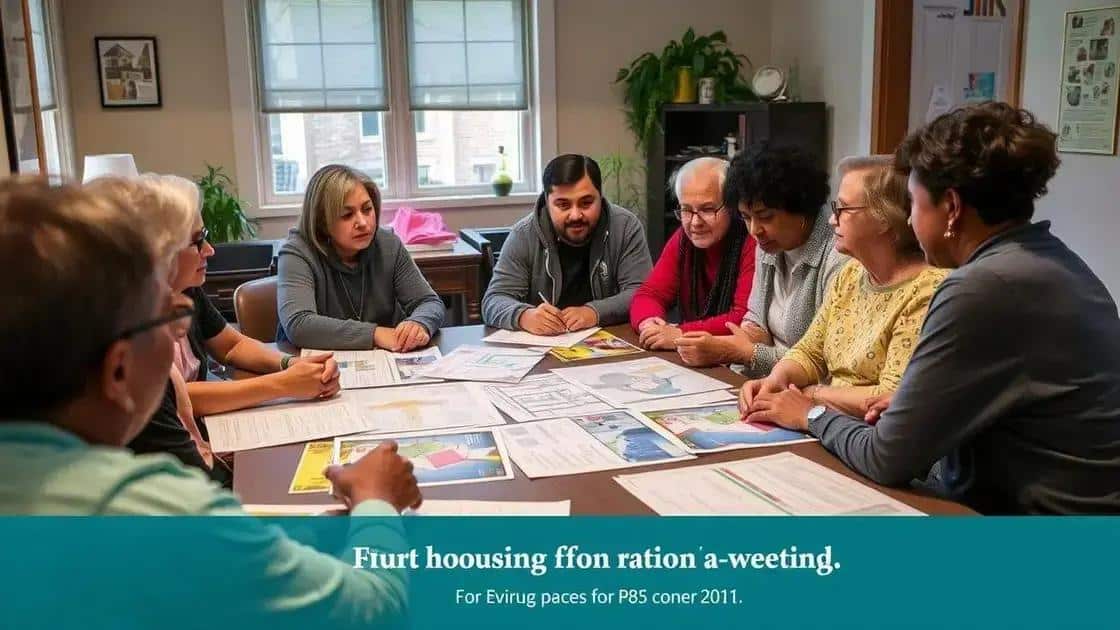Expansion of government-subsidized housing for families

The expansion of government-subsidized housing for families is vital for ensuring affordable living options, fostering community growth, and enhancing economic stability through effective local initiatives and advocacy.
Expansion of government-subsidized housing for families is more crucial than ever as we face housing challenges. Have you wondered how this initiative could enhance living conditions and strengthen communities? Let’s dive into the details!
Understanding government-subsidized housing
Understanding government-subsidized housing is essential for families seeking affordable living options. These programs aim to provide financial assistance and affordable housing solutions. But how do these initiatives impact communities and families?
Government-subsidized housing programs offer various benefits. They help create stable neighborhoods by ensuring that families have access to safe, affordable homes. Additionally, these programs can reduce homelessness and provide a pathway to financial stability.
Types of government-subsidized housing
There are several types of government-subsidized housing options available:
- Public housing: This is owned and operated by local housing authorities, providing low-income families with affordable rental options.
- Housing Choice Voucher Program: Also known as Section 8, this program allows families to rent homes in the private market with government assistance.
- Low-Income Housing Tax Credit (LIHTC): This incentivizes developers to create affordable rental housing for low-income individuals.
Understanding these types is crucial for families looking to navigate the housing market effectively. Each option has unique requirements and benefits that can help families find suitable housing.
Impact on communities
Government-subsidized housing not only impacts families but also plays a significant role in community development. When families can afford to live in a neighborhood, community resources and schools improve. A mix of income levels can lead to diverse neighborhoods where families support one another.
Moreover, these programs often promote economic growth by increasing access to job opportunities and local services. With stable housing, families can focus on education and job training, leading to overall community improvement.
As we can see, understanding government-subsidized housing is vital for these benefits to come to fruition. By participating in these programs, families can find not just a house but a community to thrive in.
Benefits for families and communities

Understanding the benefits for families and communities of government-subsidized housing is vital. These programs not only help families find safe and affordable homes but also strengthen the fabric of communities.
One significant advantage is the stability that affordable housing brings to families. When families have a secure place to live, they can focus on education and employment. This stability fosters an environment where children can thrive and achieve their academic goals.
Economic impact
Economically, government-subsidized housing programs help boost local markets. When families save money on housing costs, they have more to spend on local businesses:
- Increased spending on groceries and services
- Support for local schools and community programs
- More funds for healthcare and recreational activities
As families invest in their communities, they promote growth and development, making neighborhoods more vibrant.
Social connections
Another crucial benefit is the opportunity for social connections. Subsidized housing often places families in diverse neighborhoods, where they can meet others from different backgrounds. These connections can lead to:
- Stronger friendships and support networks
- Community events that bring residents together
- Opportunities for cultural exchange and learning
Such social interactions enhance community cohesion, making it easier for families to feel at home. They also promote a sense of belonging, which is essential for emotional well-being.
In summary, the benefits of government-subsidized housing extend beyond individual families. They positively affect entire communities, creating a ripple effect of stability, economic growth, and social connection.
Challenges in expanding housing programs
Understanding the challenges in expanding housing programs is essential for advocates and policymakers. Despite the benefits of government-subsidized housing, several obstacles can hinder growth.
One major challenge is funding. Many housing programs rely heavily on government budgets, which can fluctuate. As budgets tighten, funding for affordable housing initiatives often gets reduced, limiting the availability of new projects.
Regulatory hurdles
Another obstacle is the complex regulatory environment surrounding housing development. There are numerous local, state, and federal regulations that developers must navigate. These regulations can include zoning laws, environmental assessments, and building codes. Compliance can be costly and time-consuming:
- Lengthy approval processes can delay projects.
- Strict zoning laws may restrict where new housing can be built.
- Environmental regulations may require extensive studies and reports.
These factors can discourage developers from pursuing new subsidized housing projects, even if the demand is high.
Community resistance
Community opposition is another challenge that often arises in housing expansion efforts. Many residents may resist new developments due to fears about property values, increased traffic, or changes in neighborhood dynamics. This resistance can lead to:
- Protests and petitions against new projects.
- Political pressure on local officials to block developments.
- Divisive discussions within communities regarding housing needs.
While some residents recognize the need for affordable housing, balancing these concerns with community needs is often a struggle.
Ultimately, addressing these challenges is crucial for successful expansion. Policymakers and advocates must work together to find solutions that promote development while considering the concerns of the community and stabilizing funding.
How to get involved in local housing initiatives

Getting involved in local housing initiatives is essential for those who want to make a positive impact in their communities. Understanding how to engage effectively can empower families and strengthen neighborhoods.
One of the best ways to start is by connecting with local organizations focused on affordable housing. These groups often host meetings and events, providing opportunities for community members to learn about housing needs and ongoing projects.
Volunteer opportunities
Many organizations rely on volunteers for various tasks. Getting involved can provide firsthand experience and contribute to meaningful change:
- Helping with community outreach efforts to raise awareness about housing issues.
- Participating in local clean-up days or renovation projects for subsidized housing.
- Assisting in fundraising events to support affordable housing initiatives.
Volunteering not only helps the community but also connects you with like-minded individuals who share a passion for housing advocacy.
Advocacy and awareness
Another crucial way to get involved is by advocating for housing policies at local government meetings. Learning about the issues affecting your community is important:
- Attend town hall meetings to voice your opinions on housing development.
- Engage with local representatives to discuss the importance of expanding housing programs.
- Share information through social media to raise awareness about affordable housing needs.
By actively engaging in discussions, you can influence decisions that affect housing in your area.
Ultimately, being involved in local housing initiatives helps create a stronger, more supportive community. By taking these steps, you contribute to making affordable housing a reality for many families.
FAQ – Questions about government-subsidized housing
What is government-subsidized housing?
Government-subsidized housing refers to programs designed to help low-income families afford safe and stable homes through financial assistance.
How can I get involved in local housing initiatives?
You can get involved by volunteering with local organizations, attending community meetings, and advocating for affordable housing policies.
What are the benefits of government-subsidized housing?
Benefits include increased stability for families, economic growth in communities, and enhanced social connections among residents.
What challenges do housing programs face?
Challenges include funding limitations, regulatory hurdles, and community resistance to new housing developments.





